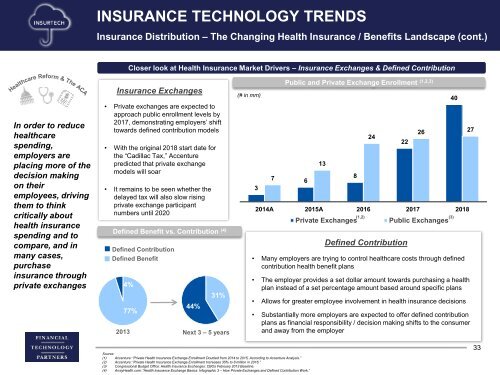You also want an ePaper? Increase the reach of your titles
YUMPU automatically turns print PDFs into web optimized ePapers that Google loves.
INSURANCE TECHNOLOGY TRENDS<br />
Insurance Distribution – The Changing Health Insurance / Benefits Landscape (cont.)<br />
Closer look at Health Insurance Market Drivers – Insurance Exchanges & Defined Contribution<br />
In order to reduce<br />
healthcare<br />
spending,<br />
employers are<br />
placing more of <strong>the</strong><br />
decision making<br />
on <strong>the</strong>ir<br />
employees, driving<br />
<strong>the</strong>m to think<br />
critically about<br />
health insurance<br />
spending and to<br />
compare, and in<br />
many cases,<br />
purchase<br />
insurance through<br />
private exchanges<br />
Insurance Exchanges<br />
• Private exchanges are expected to<br />
approach public enrollment levels by<br />
2017, demonstrating employers’ shift<br />
towards defined contribution models<br />
• With <strong>the</strong> original 2018 start date <strong>for</strong><br />
<strong>the</strong> “Cadillac Tax,” Accenture<br />
predicted that private exchange<br />
models will soar<br />
• It remains to be seen whe<strong>the</strong>r <strong>the</strong><br />
delayed tax will also slow rising<br />
private exchange participant<br />
numbers until 2020<br />
Defined Benefit vs. Contribution (4)<br />
Defined Contribution<br />
Defined Benefit<br />
4%<br />
77%<br />
44%<br />
31%<br />
2013 Next 3 – 5 years<br />
(# in mm)<br />
3<br />
7<br />
Public and Private Exchange Enrollment (1,2,3)<br />
6<br />
13<br />
8<br />
24<br />
22<br />
40<br />
26 27<br />
2014A 2015A 2016 2017 2018<br />
Private Exchanges<br />
(1,2) (3)<br />
Defined Contribution<br />
Public Exchanges<br />
• Many employers are trying to control healthcare costs through defined<br />
contribution health benefit plans<br />
• The employer provides a set dollar amount towards purchasing a health<br />
plan instead of a set percentage amount based around specific plans<br />
• Allows <strong>for</strong> greater employee involvement in health insurance decisions<br />
• Substantially more employers are expected to offer defined contribution<br />
plans as financial responsibility / decision making shifts to <strong>the</strong> consumer<br />
and away from <strong>the</strong> employer<br />
Source:<br />
(1) Accenture: “Private Health Insurance Exchange Enrollment Doubled from 2014 to 2015, According to Accenture Analysis.”<br />
(2) Accenture: “Private Health Insurance Exchange Enrollment Increases 35% to 8 million in 2016.”<br />
(3) Congressional Budget Office: Health Insurance Exchanges: CBOs February 2013 Baseline.<br />
(4) ArrayHealth.com: “Health Insurance Exchange Basics: Infographic 3 – How Private Exchanges and Defined Contribution Work.”<br />
33









